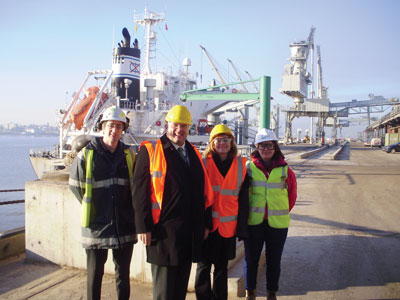
Canadian pellets heading to the UK
February 15, 2013
By Gordon Murray
In November 2011, a boatload of wood pellets left Vancouver bound for the United Kingdom.
In November 2011, a boatload of wood pellets left Vancouver bound for the United Kingdom. Four weeks later, pellets from that ship were among the first to be burned at the newly converted biomass power station at Tilbury, a small port town 40 kilometres east of London. Sandy Ferguson of BC Bioenergy Network and I visited Tilbury Power Station (TPS). Owned by RWE npower (RWE), TPS is the first major coal-fired power station in the world to be converted to run on 100% sustainably sourced wood pellets. With three power units totalling 750 MWe of capacity, TPS is the largest dedicated biomass plant in the world.
 |
|
| From left to right: Mark Flower, Gordon Murray, Sandy Ferguson and Chrissie Martin at Tilbury Power Station.
|
Operation of TPS on biomass rather than coal has resulted in greenhouse gas savings greater than 70% in comparison to coal. The conversion has also resulted in significantly lower emissions of NOx, SOx, dust and ash. In fact, the ash from wood pellets is coveted by farmers for use as fertilizer.
Upon our arrival at TPS, we were greeted by RWE representatives Nigel Staves, plant manager; Steve Bradley, project manager; Mark Flower, engineer; and Chrissie Martin, environmental consents manager. Our hosts were justifiably proud of their power station and most enthusiastic about its future.
TPS is located at an ideal site on the bank of the River Thames, tucked just a short distance upriver from the North Sea. There is a deep-water jetty capable of receiving Panamax class vessels, eliminating intermediate freight costs. Since TPS hasn’t any facilities for land storage of wood pellets, when pellets are unloaded from ships, they are conveyed directly into the boilers. Once one ship is unloaded, another ship must be ready to take its place immediately to prevent the plant from running out of pellets and having to shut down. TPS can only operate for about six hours between shipments.
Pellets are unloaded from ship-holds using Vigan pneumatic ship unloaders, which are essentially gigantic vacuum cleaners that suck the pellets out of each ship-hold and deposit them onto conveyors that transport the pellets into the power plant.
From its opening as a biomass plant in December 2012 until its expected closure in July 2013, TPS is expected to use around 1.3 million tonnes of wood pellets.
RWE is now looking into the option of extending the life of TPS, enabling it to operate as a dedicated biomass power station for another dozen or so years to around 2027. The company has submitted planning applications for the modifications that are necessary to extend the life of the power station. If successful, the plant will be closed for 15 months while construction is carried out, and then come back on line in 2015. When completed, the plant will deliver performance and emissions levels as if it were a new plant.
Once completed, TPS will operate with thermal efficiency above 37%. The plant will consume around 2.7 million tonnes of sustainably sourced, renewable wood pellets each year, which will be sourced 30% from RWE’s own 750,000 tonne-per-year pellet plant in Waycross, Georgia; 60% from Canada; and 10% from Europe.
Steve Bradley and Mark Flower explained the rationale behind pellet quality specifications. We learned the importance of small particle size due to the inability of coal mills to reduce particle size below what arrives in pellets. If particle size is too large in the boiler, then the particles will not fully combust, resulting in carbonization of the ash, thus poor fuel efficiency and difficulty in ash disposal. Pellet durability is also important because excessive dust is hazardous and is an explosion risk. Chlorine content is important because excess chlorine combines with hydrogen to create acid resulting in corrosion of the boilers. And nitrogen and sulphur levels are important as well, because if levels are too high, it leads to unacceptable emissions into the atmosphere.
Since that first shipment in November 2011, Canada’s pellet producers have shipped many more thousands of tonnes of pellets to Tilbury, thereby contributing to the greening of the UK’s power supply. We wish RWE all the best as the company works toward extending the life of Tilbury Power Station and Canada’s pellet producers look forward to sending many more boatloads in the future.
Gordon Murray is executive director of the Wood Pellet Association of Canada. He encourages all those who want to support and benefit from the growth of the Canadian wood pellet industry to join. Gordon welcomes all comments and can be contacted by telephone at 250-837-8821 or by e-mail at gord@pellet.org.
Print this page